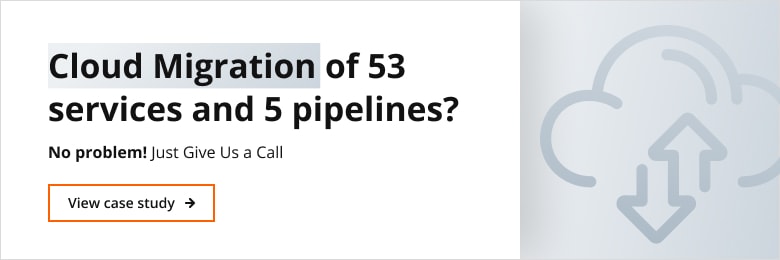
Cloud Adoption Strategy: plan, key factors and development
When developing a cloud adoption strategy, it is important that businesses don’t dive headfirst into the cloud without doing their due diligence first.
To successfully implement cloud computing in an organisation, it’s crucial to have a deep understanding of their specific needs, assess the various cloud models available, and carefully weigh the potential advantages and obstacles.
What is a Cloud Adoption Strategy?
Developing and implementing a cloud adoption strategy involves a systematic approach that organizations take to transfer their IT systems, applications, data, and workloads from on-premises environments to cloud-based solutions.
This plan includes a variety of decisions and actions that aim to facilitate a smooth and successful transition to the cloud, while also maximizing the benefits and minimizing risks.
Why does a solid Cloud Adoption Strategy matter for your business?
Having a well-defined strategy for adopting cloud infrastructure helps ensure that technology decisions are in line with business objectives, allowing for easy integration of cloud solutions and ultimately contributing to overall growth and success.
Cloud adoption is being taken up by enterprises all over the world. The cloud computing market was valued at USD 371.4 billion in 2020 and is projected to ready a staggering USD 832.1 billion by 2025.
Currently, while 94% of all enterprises use cloud services, it is thought that companies waste up to 30% of their cloud spend, which shows that there is still optimisation in this sector to be achieved.

6 key factors to consider when developing a Cloud Computing Adoption Strategy
Have a look at the six key factors to consider when adopting cloud technology:
1. Define your cloud strategy
Before doing anything, it is important for companies to think carefully about their business strategy and how their journey into the cloud will complement their end goals.
The business strategy should be defined in terms of its measurable objectives, methods that will be used to achieve those objectives, and the principles or priorities that will be used to guide decision-making.
Researching all available options and choosing the ideal cloud provider for your business is also important. Evaluate their development roadmaps and contingency plans to make sure they can meet your business goals.
2. Information security is paramount
Information security in the cloud is the primary concern of many businesses. It is important that key members of the business understand their responsibilities in terms of maintaining data protection and encryption to protect their company’s information.
This is especially important when it comes to authenticating users as the lines between corporate boundaries get blurred (especially in the remote working boom that has come about as a consequence of the COVID-19 pandemic restrictions).
3. Plan to leverage Cloud benefits
Cloud migration is a process that will take a long time – potentially even months or years, depending on how much data you have, so it is important to approach this transition strategically.
Three basic categories of cloud computing are:
Infrastructure as a service (IaaS) in Cloud – public cloud providers offer storage and computing services on a pay-per-use basis
Platform as a service (PaaS) in Cloud – provides services and workflows targeted explicitly to developers.
Software as a service (SaaS) in Cloud – delivers applications over the Internet through the web browser
Using a software-as-a-service strategy can help firms incrementally take on the cloud while not having to update or change any existing infrastructure, as opposed to a platform-as-a-service (PaaS), which might have a higher cost per solution.
A SaaS strategy lowers the implementation cost and allows the company to initiate transformations more progressively.
4. Data storage considerations
Roughly 30%-40% of the time spent during an implementation is dedicated to the data conversion process. Companies must be well prepared ahead of time to allow for efficient implementation as it’s such a significant aspect of the overall time.
Once implemented, data must be backed up regularly and have the ability to be easily restored in case of emergency.
5. Continuously re-evaluate your goals
Once you have successfully implemented your cloud migration strategy, it is crucial to continuously re-evaluate your strategy, approach, cloud provider and processes.
Don’t get locked into one single environment or vendor, as this may drastically limit the efficiency of your business. Instead, work in a multi-cloud environment and implement a system of continuous evaluation of your current services.
Research into new and emerging technical solutions in order to continue optimising your business with the best tools and services.
6. Prepare your company for cloud services usage
There are a lot of things to consider when it comes to developing a cloud adoption strategy. Accelerating digital transformation through the cloud is a complex process requiring expertise, resources, and commitment.
An IT partner with wide experience in cloud solutions will create a specific, long-term plan with tailored options.
A key element in cloud success involves finding people with the right skills and expertise. A dedicated Cloud migration team usually comes with an experienced team leader or a manager responsible for the smooth running of your project.
Read more:
- Cloud computing: the comprehensive guide
- Cloud strategy: the essential guide for planning and implementation
- Cloud Market Share and Providers Comparison
Steps to build a robust Cloud Adoption Strategy: A comprehensive guide
Whether your organisation is thinking about moving to the cloud or looking to improve its current cloud infrastructure, the following steps can help guide you through the process and ensure you get the most out of cloud technology.
Guide for successful cloud adoption
Download our comprehensive ebook for cloud adoption
Step 1: Defining your business objectives for Cloud Adoption
To fully realise the benefits of cloud adoption, it’s important to take a comprehensive approach that addresses both technical concerns and the organisation’s growth, efficiency, and competitive advantage.
Start by consulting key stakeholders, setting SMART goals and prioritising them based on potential benefits. Focus on measurable goals that address challenges and create initiatives that will deliver results.
Your cloud adoption framework should cover the entire lifecycle and align with both present and future needs and business strategies to generate significant value and drive growth.
Step 2: Evaluating your current IT infrastructure: what’s ready for the Cloud?
To evaluate if your IT infrastructure is ready for the cloud, you need to catalogue your current systems and applications. You must determine which ones are essential and check if they are compatible with cloud platforms. It’s vital to consider scalability, performance, resource utilisation, security, compliance, and data management within ongoing operations.
Applications that can benefit from cloud elasticity and meet your security and compliance needs are excellent candidates for migration. However, some may need modification or replacement to work efficiently in cloud environments.
Assess how adaptable and complex it would be to migrate each component and consider the potential advantages and disadvantages of cloud computing.
Moreover, evaluate your team’s skills and any existing obstacles, such as complex legacy systems. Use this assessment to identify which parts of your infrastructure are best suited for cloud migration.
Step 3: Choosing the right Cloud Service Model and provider
Understanding the available cloud deployment models is crucial for making informed decisions when considering a move to the cloud. As mentioned before, cloud computing offers three primary service models, each catering to specific needs and levels of control.
Step 4: Prioritizing Cloud Security and compliance
Cloud security and compliance are crucial for protecting sensitive data and maintaining stakeholder trust. Reputable cloud service providers, strong security measures, and industry-specific regulations can help reduce shared responsibility risks.
When implementing a cloud strategy prioritising security and compliance, organisations should start by performing comprehensive risk assessments to detect any potential weaknesses or gaps in compliance. These assessments are useful in determining the specific demands imposed by industry regulations and geographic mandates.
Afterwards, choosing a trustworthy and compliant cloud service provider and thoroughly evaluating their security certifications is the next crucial step.
Read our article to find out how to choose the cloud model that will be the best suited for your organisation: Which cloud architecture model is best for security?
Step 5: Budgeting for Cloud Adoption: calculating the costs
Businesses seeking to start this journey shouldn’t overlook the considerable expenses that come with cloud migration.
To effectively manage costs, it’s important to budget and forecast wisely. The process involves assessing current on-premises spending, optimising cloud usage through efficient resource management, and creating a comprehensive cloud budget that considers expenses over a specific period. Hidden costs, such as parallel environments or scaling issues, should also be considered.
Step 6: Migration, monitoring and optimizing your Cloud environment
Migration, monitoring, and optimisation provide a framework for harnessing the cloud’s full potential, delivering agility, cost savings, and robust performance.
Enterprise cloud adoption involves moving applications, data, and services to the cloud for scalability and flexibility. At the same time, monitoring ensures cloud environment health and performance, including resource usage, application performance, security threats, and user experience.
Optimising the setup for cost efficiency, performance, and resource utilisation is also essential to the strategy. Regular reviews and staying up-to-date with the latest advancements ensure continuous improvement.
Overcoming common challenges in Cloud Adoption: best practices
To successfully adopt cloud technology, organisations need to implement strategic approaches:
To comply with data sovereignty regulations, choosing cloud services with data centres in the required regions is important.
Security concerns can be addressed by using encryption, access controls, and following industry standards.
The lack of skilled personnel can be resolved by investing in staff training, utilising managed services, or hiring cloud experts.
Vendor lock-in concerns can be eliminated by selecting providers prioritising open standards and multi-cloud strategies.
To manage costs effectively, monitoring resource usage, optimising allocation, and using reserved instances is recommended.
Lastly, integration hurdles can be overcome through vendor-provided integration tools or customised solutions tailored to legacy systems.
Customising these practices based on an organisation’s unique context is crucial for successful cloud adoption while minimising potential obstacles.
Want to create or evaluate your Cloud Adoption plan?
However, taking on a cloud adoption strategy is not without its risks, as there are plenty of possible pitfalls and areas to watch out for. That’s why a thorough evaluation and risk assessment are essential. This involves assessing factors such as data security, connectivity reliability, technical support availability, and alignment with your business goals.
Security is always the main concern for companies adopting this strategy, and providers must continuously develop their systems to withstand data theft, data leakage, service hacking and DDOS attacks.
A constant and reliable internet connection is a must to use a cloud-based service because, without this, you simply won’t get connectivity. Technical issues do occur, and these could harm your business, and it is sometimes difficult to get the right level of support in a timely fashion.
On the other hand, the business outcomes that cloud adoption strategy can bring are probably countless – Cloud solutions are the fastest-growing sector of the IT market. Annual growth of 30% results makes the expected value of the cloud market $500bn by 2023.
So, if you think that developing a cloud adoption strategy could be a great option for you, why not have a go?
If you’re seeking expert guidance to navigate the complexities of cloud adoption and ensure a seamless transition, reach out to Future Processing for reliable assistance and tailored solutions.





